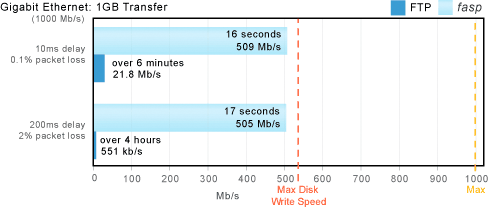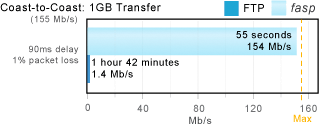The Company
FileSociety™ is a service developed and hosted by Industrial Color Software (a division
of Industrial Color, Inc.). Industrial Color Software pioneered on-line digital image workflow
from the early days of professional digital photography with its GLOBALedit® web
application. GLOBALedit® is used by thousands of users including many Fortune 500 companies such as Limited Brands,
CBS and Time Warner to automate high-volume digital image review, management and
distribution.
Always looking to find ways to provide greater productivity to their clients, GLOBALedit®
integrated Aspera’s Fasp™ technology into its core application to enable
incredibly high-speed file transfers of very large image files anywhere over the
web. That changed everything. Clients immediately moved away from outdated, unreliable
and insecure technology like FTP, and manual processes like CD/DVD shipping, and
switched to GLOBALedit™ to share and distribute files with internal teams
and global partners.
It was clear that a new service needed to be developed and hosted that would give
anyone the power to safely manage and distribute large files and file sets of any
kind, provide user and group access control and set of workflow features to allow
organizations to control their files instead of being controlled by them. In 2008,
FileSociety™ was born.
[top]
Technology
FileSociety™ integrates Aspera’s Fasp™ technology to deliver files
up to 100 times faster than FTP. Unlike TCP, Fasp™ uses standard UDP and achieves
reliability in the application by retransmiting only the real packet loss. Fasp™
efficiently transmits in a single stream rather than dividing the file into chunks
and uses automatic adaptive rate control to eliminate latency to fully utilize available
bandwidth while maintaining balanced traffic to other users. FileSociety™
works with any web connection and popular browsers and does not require any special
hardware, management or IT.
Security
Complete Security - FileSociety’s™ utilization of the
Fasp™ protocol provides complete built-in security without compromising transfer
speed. The security model, based solely on open standards cryptography, consists
of secure authentication of the transfer endpoints using the standard secure shell
(SSH), on-the-fly data encryption using strong cryptography (AES-128) for privacy
of the transferred data, and an integrity verification per data block, to safeguard
against man-in-the-middle and anonymous UDP attacks. The transfer preserves the
native file system access control attributes between all supported operating systems,
and is highly efficient: With encryption enabled, Fas™p achieves WAN file
transfers of 40-80 Mbps on a laptop computer; 100-150 Mbps on a P4 or equivalent
single processor machine; and 200-400 Mbps+ on dual-processor or duo-core workstations
Secure Endpoint Authentication - Each transfer session begins with
the transfer endpoints performing a mutual authentication over a secure, encrypted
channel, using SSH ("standard secure shell"). SSH authentication provides
both interactive password login and public-key modes. Once SSH authentication has
completed, the Fasp™ transfer endpoints generate random cryptographic keys
to use for bulk data encryption, and exchange them over the secure SSH channel.
These keys are not written to disc, and are discarded at the end of the transfer
session.
On-the-fly Data Encryption - Using the exchanged keys, each data
block is encrypted on-the-fly before it goes on the wire. Fasp™ uses a 128-bit
AES cipher, re-initialized throughout the duration of the transfer using a standard
CFB (cipher feedback) mode with a unique, secret nonce (or "initialization
vector") for each block. CFB protects against all standard attacks based on
sampling of encrypted data during long-running transfers
Integrity Verification - Fasp™ accumulates a cryptographic
hashed checksum, also using 128-bit AES, for each datagram. The resulting message
digest is appended to the secure datagram before it goes on the wire, and checked
at the receiver to verify message integrity. This protects against both man-in-the-middle
and re-play attacks, and also against anonymous UDP denial-of-service attacks
Fasp File Transfer Compared to FTP
The following graphs compare file transfer throughput and transfer time for fasp
file transfer and FTP file transfer in typical network scenarios. All fasp and FTP
benchmarks are for file transfer tests run within the Aspera labs. In each test,
a 1-gigabyte file was transferred between commodity Pentium-4 computers running
Debian Linux, using a standard Debian Linux implementation of FTP and Aspera Scp
for fasp file transfer. A nistnet network emulator was used to simulate network
round-trip latency and packet loss conditions typical on the Internet. Actual FTP
throughputs will depend on the particular implementation of FTP used, the operating
system, and the particular network loss pattern, but the results shown are typical.
fasp vs. FTP on Gigabit Metropolitan and Wide Area Networks
Conventional TCP file transfer technologies such as FTP dramatically reduce the
data rate in response to any packet loss, and cannot maintain long-term throughputs
at the capacity of high-speed links. For example, the maximum theoretical throughput
for TCP-based file transfer under metropolitan area network conditions (0.1% packet
loss and 10 ms RTT) is 50 megabits per second (Mbps), regardless of bandwidth. The
effective FTP throughput is even less (22 Mbps). In contrast, fasp achieves 100%
utilization of high-speed links with a single transfer stream.

In the particular test shown, the fasp throughput on a gigabit ethernet MAN (509
Mbps) presses the disk read/write speed limits of the endpoint computers. Perhaps
more important, fasp maintains this throughput even as latency and packet loss increase
(505 Mbps at 200 ms/2%). FTP throughput degrades to about 550 Kbps under the same
conditions. While this 1000X speed advantage over traditional TCP transfers is only
evident on the fastest long-haul networks, it illustrates the difference in the
fasp approach.
fasp vs. FTP on Cross-continental Links
Aspera fasp sustains the highest possible end-to-end file transfer rates on cross-continental
and intercontinental file transfers where latencies are high and packet loss is
variable. An FTP file transfer from LA to New York (90 ms) will achieve 5-6 Mbps
when loss is low (0.1%). As congestion on the link increases (1%), FTP dramatically
reduces its rate to 1.4 Mbps. In contrast, fasp transfers data at link capacity.
On a 155 Mbps link with 90 ms/1%, fasp transfers at 154 Mbps, 100 times faster than
FTP. Using a more typical 45 Mbps link, the transfer is still 30 times faster than FTP.
